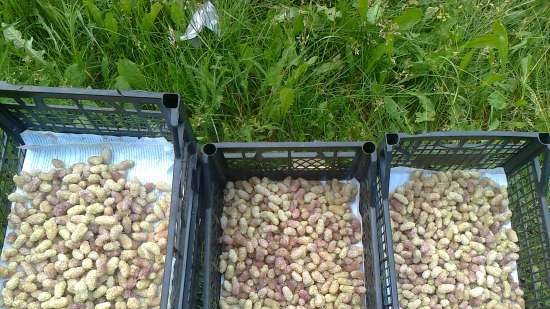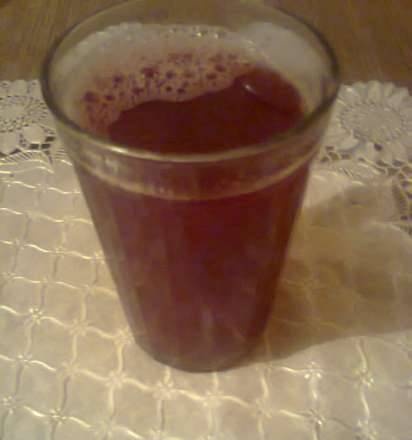|
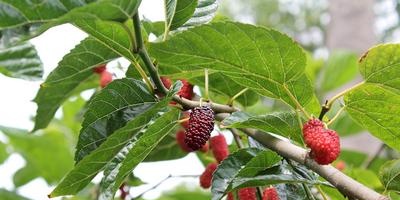 When I first flew to the Pamirs, I was very surprised to see trees on the mountains, cut in the same way as in the city. At first I took them for poplars and wondered: why cut the trunks here, among the mountains? When I first flew to the Pamirs, I was very surprised to see trees on the mountains, cut in the same way as in the city. At first I took them for poplars and wondered: why cut the trunks here, among the mountains?
He came closer. No, not poplars. The leaves are not the same: the leaf is lobed, beautifully carved. Somewhere I have met such, but where and when? And then I remembered one incident from the war times.
I was lying after being wounded in a hospital in the city of Dnepropetrovsk. Several large trees grew in the yard. Summer was over, and berries resembling raspberries hung densely on the branches. Tree raspberry?
“Mulberry,” said the nurse who was on duty in our ward. “Would you like me to bring you berries?
She dialed a whole jar of them. The berries were sweet but bland. I didn't like them. In the evening they gave juice. My sister told me to drink it. He brings the most severe patients back to their feet. I drank the juice and felt the strength return to me. Soon he went to the front again.
And now I stand before the tree of my youth. But there is not a single berry. They can't be. The crown is cut so often that only fresh, thin shoots have time to grow. Juicy leaves appear on them, twice as large as usual. They are given for lunch to silkworm caterpillars. The silkworm produces natural silk.
Of course, mulberries are not grown in Central Asia alone. They are planted in Europe and Asia. There are especially many trimmed trees in Japan. They give the landscape of this country "an unusual monotony". The history of mulberry cultivation is full of mysterious events. Here is one of them. In Greece, there are still stories of two monks who committed a sin for the prosperity of silkworm breeding. Dressed as pilgrims, they stole silkworm eggs from Persia in 555. Then, having drilled the staves, stuffed the stolen goods and thus overcame the border inspection. From that time until the Second World War, Greece produced silk.
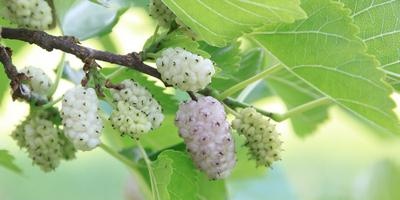 It is not known how many years the silk idyll would have lasted if artificial fibers had not been invented. By the beginning of World War II, synthetic silk was obtained. Natural seemed unprofitable. Mulberry trees remained an unnecessary luxury. Now they only took up extra space that could be used for another culture. But the peasants were sorry to cut down their breadwinners. Some mafusaila were 150 years old or older. They were planted by their grandfathers, great-grandfathers and great-great-grandfathers. The life of entire dynasties passed under their ridiculous broom-shaped crowns. Cutting out cripples means breaking the connection with the past! It is not known how many years the silk idyll would have lasted if artificial fibers had not been invented. By the beginning of World War II, synthetic silk was obtained. Natural seemed unprofitable. Mulberry trees remained an unnecessary luxury. Now they only took up extra space that could be used for another culture. But the peasants were sorry to cut down their breadwinners. Some mafusaila were 150 years old or older. They were planted by their grandfathers, great-grandfathers and great-great-grandfathers. The life of entire dynasties passed under their ridiculous broom-shaped crowns. Cutting out cripples means breaking the connection with the past!
Land was scarce, but the Greeks were waiting. What if something changes? What if natural silk will come back into fashion and take its rightful place in the world of fibers? And they were right. Natural silk is back. The world wears crepe de chine, crepe georgette and chiffon again. And the southern mulberry tree is back in value.
By the way, even though mulberry is a southerner, at one time they tried to breed it in Moscow. And not without success. In 1855, a sericulture school was inaugurated in Moscow under the Imperial Society of Agriculture. A sericulture committee arose, which began to cultivate mulberry seedlings. Of course, she could not grow a large tree in the suburbs, but this was not required. The main thing is to have fresh leaves every year. And if in some winters our heroine froze to the root collar, then the roots remained and the next spring strong, vigorous shoots with juicy foliage appeared. It is remarkable that the leaves remained green until the end of July and even until mid-August, because there is no drought near Moscow, as in the southern borders of the country.
At one time, the Moscow region specialized in sericulture so much that its products could not be distinguished from the best foreign varieties!
They learned about the successes of the Moscow silkworm breeders in Novgorod and decided to receive their own, Novgorod silk.We wrote to the magazine asking for advice. The magazine expressed doubt: mulberry barely tolerates the climate of Moscow, where can you, northerners! Of course, you can try, but keep in mind that you will have to tie each tree with straw bundles. Moroka! It seems that after such an answer, the Novgorodians did not dare to try ...
They tried to solve the silk problem in a different way. In the middle of the last century, a French silkworm breeder from the city of Avignon tried to replace mulberry leaves with others. I tried many herbs and settled on a goat. This creation is akin to a chamomile and sunflower... From the same family of Compositae. A golden basket resembles a dandelion, only the leaves are not carved, but whole, like those of lilies. In its composition, goat leaves are an exact copy of mulberry leaves. Something is still missing there, so the silkworm breeder did this: he immersed the leaves in a sugar solution, adding gum and ammonia there. And for the scent, a little bit of mulberry stem extract. The deception was successful. The caterpillars did not notice the difference and devoured the goat leaves greedily. They were cut every week since May. The silk came out first-class.
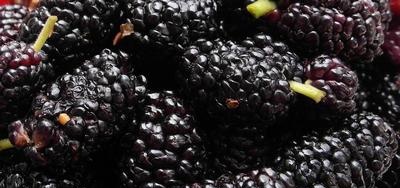 And now more about berries. They are different. The white mulberry is light, slightly yellowish, the black mulberry is dark-maroon, almost black. Writer L. Gurunts, when he learned that shah-tutu (black tutu) is being cut down in Dagestan in order to free the land for other crops, was terribly upset and began to calculate how much usefulness the berries have. The list is very long. It turned out that they are being treated for all diseases. If you are not sick with anything, but quite healthy, drink juice for prevention. It is also good. He wrote a long story about this and published it in Novy Mir. And now more about berries. They are different. The white mulberry is light, slightly yellowish, the black mulberry is dark-maroon, almost black. Writer L. Gurunts, when he learned that shah-tutu (black tutu) is being cut down in Dagestan in order to free the land for other crops, was terribly upset and began to calculate how much usefulness the berries have. The list is very long. It turned out that they are being treated for all diseases. If you are not sick with anything, but quite healthy, drink juice for prevention. It is also good. He wrote a long story about this and published it in Novy Mir.
If we turn to history again, then mulberry berries have served people for a long time. The famous academician N. Vavilov was the first to draw attention to this. Passing the mountain villages of the Hindu Kush, he was surprised that the inhabitants did not sow grain at all. No wheat, no rye, no barley. The gorges are narrow. There is simply nowhere to sow. However, tortillas are eaten. What are they made of? From dried mulberry berries. Milled into powder. Add some flour. The academician called these villages “mulberry villages”.
Our Tajiks used to bake the same flat cakes, when in winter snow covered mountain gorges and valleys. They pounded Black Mulberry Berries and got a dark brown flour. The flat cakes tasted like honey cakes. Of course, they were much healthier than them and very satisfying. By the way, the same cakes are baked today in Syria. Professor-botanist L. Rodin, traveling through this "land of deep wells", ate these cakes. And we can draw one important conclusion from this fact: since there are “deep wells”, it means that the water is far away and only a very drought-resistant tree can survive in such a country. Tuta is just that!
A. Smirnov. Tops and roots
Pebrina
- Do you know how serious your illness is? You are at risk of paralysis.
- I know, but I cannot leave the work started.
The doctor asked, and Pasteur, the famous French microbiologist, answered. And the work that Pasteur could not leave was the study of the mysterious spotted disease of caterpillars. Because of these sick caterpillars in the nineties of the last century, Pasteur arrived in the south of France in the city of Ale. It was quiet and gloomy in Ale. Because of the disease of caterpillars, entire areas were ruined, the life of cities froze. Famine came to the south of France. The south of France lived and fed on sericulture. In Ale, the mulberry trees were called "golden" because they were fed by the leaves of the silkworm caterpillars. And suddenly the caterpillars began to die in the thousands. Their body was covered with black spots, as if someone had sprinkled them with pepper, they became lethargic and died. How did the silkworm breeders try to treat their sick caterpillars: some sprinkled them with sugar, some with mustard, some with coal; gave them a leaf sprinkled with wine - and all in vain.
Italian scientist Cornalia, examining diseased caterpillars under a microscope, found tiny mobile bodies in them.But what do these "Cornalian bodies" have to do with caterpillar disease? Before Pasteur's work, no one knew this.
Pasteur fiddled with sick caterpillars for five years. Days and nights he sat in the laboratory, then in the wormhole, where even a healthy person found it difficult to breathe because of the heat and the stench of decomposing caterpillars.
Paralyzed, lying on the train, Pasteur arrived in Ale again. He knew that an entire branch of the economy was dying, hungry people were waiting for help. Never before had Pasteur dealt with caterpillars. Going to go to Ale, for the first time in his life he took a cocoon in his hands, shook it over his ear and was surprised that "there is something in the middle."
But Pasteur was a great germ hunter. And he was able to establish that the "cornal bodies" are bacteria - the cause of illness and death of caterpillars. He proved that the spotted disease - pebrin - is inherited. Sick caterpillars will hatch from the testicles laid by a sick butterfly. And besides, pebrina is contagious.
Pasteur pounded sick caterpillars in a porcelain mortar, mixed the gruel with water and sprinkled the leaves plucked for food by healthy caterpillars. He placed the eaten poisoned leaves of healthy caterpillars in a cage marked with two crosses. And in the cage, marked with one cross, caterpillars were settled, eating leaves sprinkled with gruel made from the crushed bodies of healthy caterpillars. And twelve days later, the caterpillars sitting in the cage under two crosses became covered with black spots, and the caterpillars from the cage under one cross were completely healthy.
Pasteur did not undertake to treat the caterpillars, but he suggested a sure way to stop the spread of the disease and protect the healthy. The corpse of a butterfly that has laid testicles should be examined under a microscope. If the butterfly is sick, its gren (testicles) must be destroyed.
At that time, antiseptics and disinfection were not known even in medicine. Now, thanks to Pasteur's work, silkworm breeders all over the world know how to deal with the spotted caterpillar disease - pebrin.
How the silkworm got to Europe
For several thousand years the Chinese were engaged in silkworm breeding, but they kept their art in strict secrecy. Under the threat of the death penalty, it was forbidden to export silkworm caterpillars from China.
There was a great demand in Europe for dense and light silk fabrics; but these fine fabrics could only be bought from the Chinese.
In 550, the Roman emperor Justinian reigned in Constantinople. Two seasoned monks went to visit Justinian's palace. They used to live in China, knew the Chinese language and customs, and Justinian gave the monks a secret mission: to penetrate the land of silk and bring the forbidden caterpillars from there in any way. The monks knew that if the Chinese caught them with caterpillars, then they would not blow their heads off. But the emperor promised a rich reward.
For a long time nothing was heard of the monks. They went on foot to China, walked around the country, looked out and inquired. We went on foot and back. They had no luggage with them. Poor wanderers are walking, leaning on a staff. And none of the Chinese suspected them.
And so the emperor was informed that the monks sent to China had returned. Justinian ordered to bring them to the palace. The monks bowed, and one placed his wandering staff - a bamboo cane at the emperor's feet.
How was it to be understood? As a request for mercy, or perhaps as a mockery? In anger, the emperor looked at the stick, then at the monks. And the monk said: "Tell me to break the staff." The bamboo staff was shattered, and silkworm eggs fell to the floor.
The emperor ordered the construction of a secret wormhole at the palace, and there, under the guidance of monks-travelers, trusted women began to learn how to care for caterpillars. This is how the legend tells about how sericulture in Europe began from a handful of cunningly obtained grains.
J. Adolf
|
 When I first flew to the Pamirs, I was very surprised to see trees on the mountains, cut in the same way as in the city. At first I took them for poplars and wondered: why cut the trunks here, among the mountains?
When I first flew to the Pamirs, I was very surprised to see trees on the mountains, cut in the same way as in the city. At first I took them for poplars and wondered: why cut the trunks here, among the mountains? It is not known how many years the silk idyll would have lasted if artificial fibers had not been invented. By the beginning of World War II, synthetic silk was obtained. Natural seemed unprofitable. Mulberry trees remained an unnecessary luxury. Now they only took up extra space that could be used for another culture. But the peasants were sorry to cut down their breadwinners. Some mafusaila were 150 years old or older. They were planted by their grandfathers, great-grandfathers and great-great-grandfathers. The life of entire dynasties passed under their ridiculous broom-shaped crowns. Cutting out cripples means breaking the connection with the past!
It is not known how many years the silk idyll would have lasted if artificial fibers had not been invented. By the beginning of World War II, synthetic silk was obtained. Natural seemed unprofitable. Mulberry trees remained an unnecessary luxury. Now they only took up extra space that could be used for another culture. But the peasants were sorry to cut down their breadwinners. Some mafusaila were 150 years old or older. They were planted by their grandfathers, great-grandfathers and great-great-grandfathers. The life of entire dynasties passed under their ridiculous broom-shaped crowns. Cutting out cripples means breaking the connection with the past! And now more about berries. They are different. The white mulberry is light, slightly yellowish, the black mulberry is dark-maroon, almost black. Writer L. Gurunts, when he learned that shah-tutu (black tutu) is being cut down in Dagestan in order to free the land for other crops, was terribly upset and began to calculate how much usefulness the berries have. The list is very long. It turned out that they are being treated for all diseases. If you are not sick with anything, but quite healthy, drink juice for prevention. It is also good. He wrote a long story about this and published it in Novy Mir.
And now more about berries. They are different. The white mulberry is light, slightly yellowish, the black mulberry is dark-maroon, almost black. Writer L. Gurunts, when he learned that shah-tutu (black tutu) is being cut down in Dagestan in order to free the land for other crops, was terribly upset and began to calculate how much usefulness the berries have. The list is very long. It turned out that they are being treated for all diseases. If you are not sick with anything, but quite healthy, drink juice for prevention. It is also good. He wrote a long story about this and published it in Novy Mir.